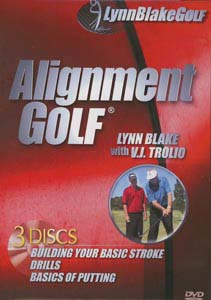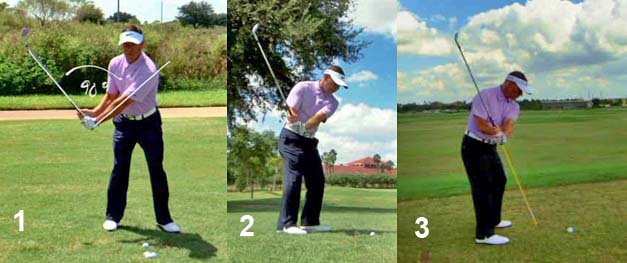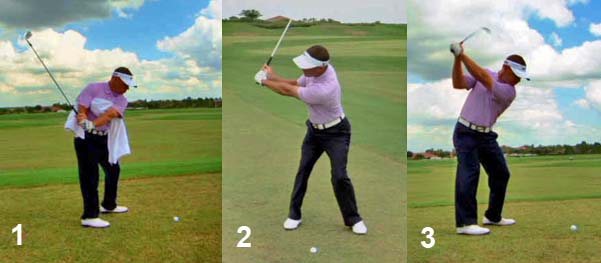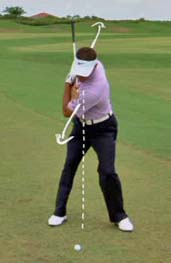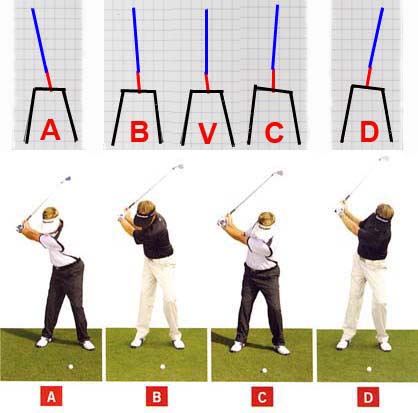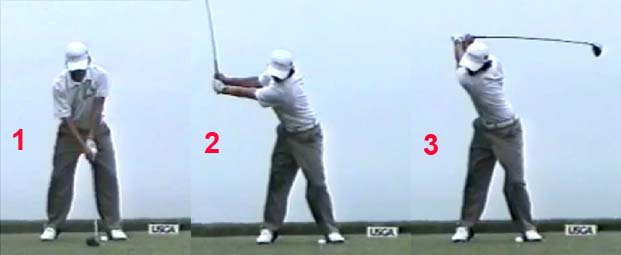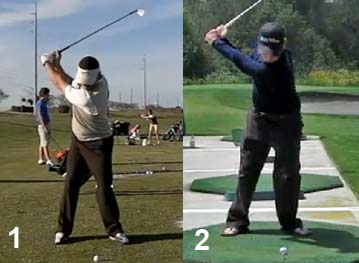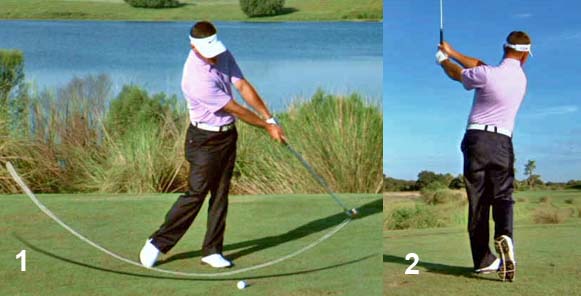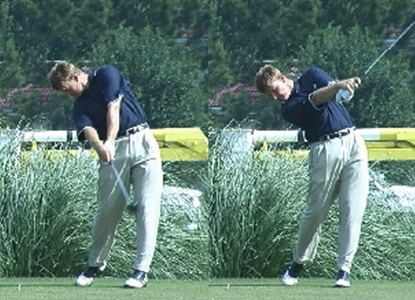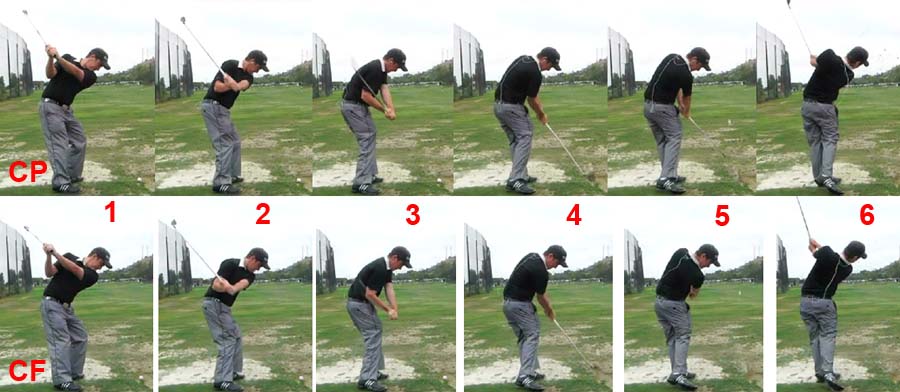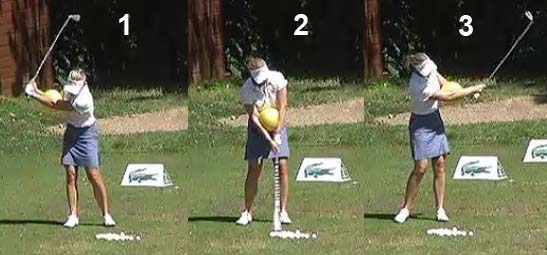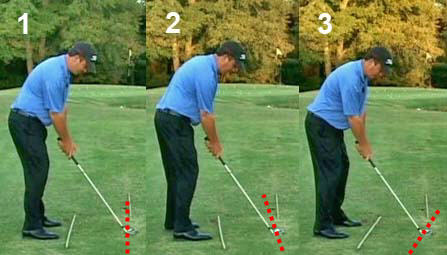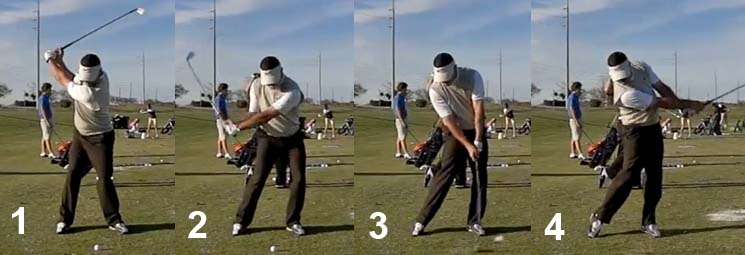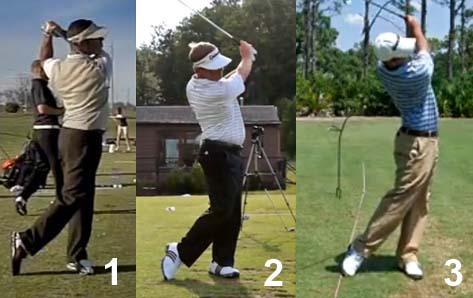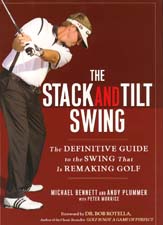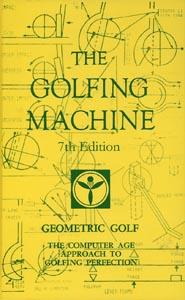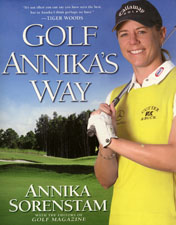Critical Review: "Next Generation with Sean Foley" DVD
Click here to go back to the home page.
Introduction
In this review paper, I am going to review Sean Foley's golf instructional teaching as he presented it in his "Next Generation with Sean Foley" DVD [1]. He markets his DVD with the marketing hype that "once every generation everything changes", thereby implying that his golf swing instructional teaching is revolutionary. However, his golf swing teaching methodology is very similar to Mike Bennett/Andy Plummer's S&T swing methodology, which Bennett/Plummer also promoted as being revolutionary - as being the "definitive swing that is remaking golf". In this review paper, I will compare these two swing styles in great detail, and I will also demonstrate what they have in common. I will subsequently also delineate how they differ from the traditional/conventional swing, which I have described in inordinate detail in my many review papers.Sean Foley was previously known as the golf instructor who taught the PGA tour professional golfers - Sean O'Hair, Hunter Mahan and Stephen Ames. However, he gained more renown when he started to coach Tiger Woods, who recently divorced himself from Hank Haney's teaching influence. One can identify certain changes in Tiger Woods' 2011 swing, which are a direct result of Sean Foley's teaching influence, and it will take a number of years to determine whether those swing changes will benefit Tiger's swing (presuming that he doesn't change to another swing coach in the next few years).
The teaching material in Sean Foley's DVD is very basic and very non-detailed, and he doesn't provide explicit information regarding many of his teaching ideas. However, it is relatively easy to infer what he is trying to accomplish regarding his overall swing style, because it is very similar to Bennett/Plummer's S&T swing style. Many S&T proponents believe that Sean Foley learnt most of his swing philosophy from Bennett/Plummer, although Sean Foley has stated that he derived only 5% of his teaching ideas from Bennett/Plummer's S&T teaching philosophy. Despite Sean Foley's 5% claim, I can personally identify many aspects of Sean Foley's swing that is also fundamental to the S&T swing, and I will describe those common features in this review paper.
It is very surprising how many grammatical and factual errors Sean Foley made in his DVD. To appreciate how many errors he made, you can read this independent review article written by Erik Barzeski [2]. I will not discuss all these errors in this review paper, as I am primarily interested in reviewing his personal swing approach from a conceptual perspective.
Sean Foley's swing teaching methodology - as presented in his DVD
AddressSean Foley starts off by describing the posture that he adopts at address. He emphasises certain points - like being in active balance, gripping the ground with one's feet, and "feeling" solidly grounded. However, there is nothing new or different in this "address posture approach" - it is essentially identical to the address posture that I described in my Address Setup, Posture, and Alignment chapter, except that I emphasise a slight tilt of the spine to the right that causes the right shoulder to become significantly lower than the left shoulder at address. Sean Foley only recommends a rightwards-tilted spine at address for a driver swing.
At address, Sean Foley appears to be weighted equally on both feet, and his spine is relatively centralised. By contrast, Bennett/Plummer recommend a weight distribution of 55:45 weighted more towards the left side at address for their S&T swing - although they also recommend a vertical-centralised spine at address [3]. Bennett/Plummer describe their address position as a situation where the head/upper swing center is vertically stacked over the lower swing center with the weight slightly forward, while Sean Foley is more vague in his description and he only recommends a centralised posture without mentioning the two swing centers.
Takeaway
Sean Foley recommends starting the takeaway by first moving the clubhead with the hands, and then moving the arms => upper torso (shoulders) => lower torso. This represents a delayed hip turn swing style, which is perfectly acceptable. There is nothing unusual in Sean Foley's takeaway action. He allows his left forearm to pronate and he allows the toe of his club to point straight-up at the end-takeaway position - by using a standard takeaway swivel action.
Mid-backswing action
Sean Foley uses a right forearm takeaway action, rather than a one-piece takeaway action. That causes an early setting of the left wrist - due to the fact that the right elbow bends early during the backswing action.
Sean Foley's mid-backswing action - capture images from his DVD [1]
Note that Sean Foley has already acquired a 90 degree angle between his left arm-clubshaft by the time he reaches the early stage of his mid-backswing - image 1. That phenomenon is made easily possible secondary to the fact that he allows his right elbow to bend - a biomechanical action that allows the right wrist to more easily bend back (dorsiflex) while the left wrist cocks upwards (radially deviates). Sean Foley states that he wants the club to "feel" lighter by the early phase of his mid-backswing by allowing the club to become near-vertical to the ground - image 2. He states that he wants the butt end of the club to point "somewhere" between his feet and the ball at this stage of his mid-backswing - image 3 shows that a stick (inserted into the butt end of his club) points at the ground at a point that is roughly midway between his feet and the ball. Sean Foley does not attempt to keep his clubshaft "on-plane" during his mid-backswing - using Homer Kelley's definition of "on-plane" where the butt end of the club points at the ball-target line [4].Another point that Sean Foley emphasises in his DVD is the "feeling" of keeping the arms closely connected to the torso during the backswing action. He recommends using the "towel" drill to engrain this "feeling" of arm-torso connectedness.
Sean Foley's mid-end backswing action - capture images from his DVD [1]
Image 1 shows how Sean Foley places a towel under his left and right armpits, and he encourages keeping both upper arms closely applied to the upper chest wall (armpits) during the backswing action so that the towel doesn't drop-out. Note that his hands are "deeper" (further away from the ball-target line) in this image (and also in image 2) - compared to the image above, where he has a stick placed in the butt end of his club. In this image, he looks very similar to a S&T golfer who also keeps both upper arms more closely connected to the upper chest wall (armpits) during the backswing action - and where the hands move more "deep" (away from the ball-target line) as the left arm is pulled across the upper chest wall.End-backswing action
At his end-backswing position, note that Sean Foley has his left arm across his shoulder turn angle, and he has his right forearm is roughly parallel to the spine angle - image 3. That appearance is very similar to that of a S&T golfer.
Note that Sean Foley keeps his right knee flexed throughout his backswing action, and he doesn't deliberately straighten his right leg - as recommended by Bennett/Plummer for their S&T swing. Therefore, his right pelvis is not necessarily as uplifted/elevated at the end-backswing position - compared to a S&T golfer.
Note that Sean Foley's shoulder turn angle at the end-backswing position - image 3 - is relatively steep, and it is very similar to that seen in a S&T golfer. Sean Foley recommends turning the shoulders more steeply during the backswing, although he is very vague in his description of this shoulder-steepening action.
Sean Foley demonstrating his steeper shoulder turn action - capture image from his DVD [1]
In his DVD, Sean Foley recommends turning the shoulders more steeply during the backswing action - so that the left shoulder tilts downwards in the direction of the ball, while the right shoulder moves more upwards. However, Sean Foley doesn't describe the biomechanical actions needed to acquire this particular end-backswing "look" - which I have arbitrarily labelled a vertical-centralised backswing action swing style.Consider the variations in backswing pivot action that can be performed by a golfer.
Variations in backswing pivot action - original image derived from reference number [3]
The bottom half of the composite image is derived from Bennett/Plummer's S&T book [3]. The top half of the composite image consists of hand-drawn diagrams of the legs/pelvis (in black), lumbar spine (in red) and thoracic spine (in blue).Image A shows a golfer who has a large amount of tilt of the upper torso rightwards (away from the target) at the end-backswing position. The associated diagram demonstrates that the pelvis is relatively horizontal to the ground, and that both the lumbar spine and thoracic spine are tilted to the right. That is what would happen if a golfer allowed his thoracic spine to synchronously rotate in sympathy with the rotation of his pelvis/lumbar spine during his backswing action - without using any arch-extension maneuver to arch-extend the thoracic spine towards the target during the backswing action.
Rickie Fowler uses this type of backswing pivot action - http://www.youtube.com/watch?v=i0HGi-xdz8g
Rickie Fowler's backswing pivot action - capture images from his swing video
Note how horizontal Ricky Fowler's shoulder turn angle is at the end-backswing position, and note that he doesn't dip his left shoulder down towards the ball (image 3).Image B shows a golfer who has a lesser amount of tilt of the upper torso rightwards (away from the target) at the end-backswing position. The associated diagram shows that the thoracic spine is less tilted to the right - which means that the golfer is using an arch-extension maneuver of his thoracic spine (while the thoracic spine is rotating) to keep his upper torso/head more centralised between his feet during his backswing action. Note that the pelvis is relatively horizontal to the ground. I refer to this backswing action as a rightwards-centralised backswing action. The majority of professional golfers use this type of backswing pivot action, and I have described this type of backswing action in my backswing chapter.
Image C shows a golfer who has a minimal tilt of the upper torso leftwards (towards the target) at the end-backswing position. The associated diagram shows that the lumbar spine is more vertical (due to a slight uplifting of the right pelvis due to a right leg straightening action) and that the thoracic spine is slightly tilted to the left (relative to the lumbar spine) - and that is due to the utilisation of a greater amount of arch-extension of the thoracic spine during the backswing action. Bennett/Plummer recommend image C for their S&T swing - and they recommend a greater amount of arch-extension of the thoracic spine during the backswing action, in order to keep the head/upper swing center vertically stacked over the lower swing center. I refer to this type of backswing action as a leftwards-centralised backswing action.
Image D shows a golfer who has a large degree of reverse-pivoting due to the tilting of his entire upper torso leftwards (towards the target). Note that the right pelvis is uptilted due to a straightening right leg, and note that the entire spine is tilted leftwards (towards the target). I have never seen professional golfers use this type of backswing pivot action.
Image V represents a vertical-centralised backswing action where the golfer has a relatively horizontal pelvis (due to the avoidance of a right leg straightening action) and where the thoracic spine is more vertical at the end-backswing position - intermediate between a rightwards-centralised backswing action and a leftwards-centralised backswing action in terms of the amount of arch-extension of the thoracic spine that is utilised during the backswing action.
Sean Foley teaches this type of vertical-centralised backswing pivot action.
In other words, the major difference between a rightwards-centralised, vertical-centralised and a leftwards-centralised backswing action is the *amount of arch-extension of the thoracic spine that is utilised during the backswing action.
(* I have demonstrated this arch-extension maneuver in this 10 minute swing video lesson - http://www.ustream.tv/recorded/11227744)
What is important to realise is that the shoulders will automatically/naturally rotate around the upper thoracic spine along a rotary/arced path that is roughly perpendicular to the axis of the upper thoracic spine. Therefore, the shoulders will rotate more steeply (and less horizontally) if the upper thoracic spine becomes more verticalised during the backswing action due to the utilisation of a greater amount of arch-extension of the thoracic spine during the backswing action. That biomechanical phenomenon happens in both a vertical-centralised backswing action and a leftwards-centralised backswing action.
Certain S&T golf instructors do not teach a leftwards-centralised backswing action swing style, and they prefer to teach a vertical-centralised backswing action swing style. Then, the major difference between their S&T teaching and Sean Foley's teaching (with respect to the backswing pivot action) is that Sean Foley keeps the right knee slightly flexed and the pelvis relatively horizontal, while the S&T instructor usually encourages more right leg straightening and therefore more uptilting of the right pelvis during the backswing action. In both cases, the golfer is instructed to have a steeper shoulder turn angle at the end-backswing position - due to the adoption of a vertical-centralised backswing action swing style. At the end-backswing position, the S&T golfer will often "appear" to have his weight slightly more forward (over a flexed left leg) compared to Sean Foley's end-backswing appearance where he "appears" to be more weight-centralised.
Consider an U-tube video of Sean Foley's swing - http://www.youtube.com/watch?v=Qor3Wc7GTEg
and
an U-tube video of a S&T instructor's, Dan Carraher's, S&T swing - http://www.youtube.com/user/mysdgi#p/u/73/q6Nnf2wLINo
End-backswing position of Sean Foley and Dan Carraher - capture images from their swing videos
Note that both golfers are using a vertical-centralised backswing action - where the thoracic spine is roughly vertical to the ground at the end-backswing position.Note that Sean Foley keeps his pelvis centralised between his feet, while Dan Carraher has shifted his pelvis more leftwards (due to his right leg straightening action) and he "appears" to be more weighted over the left leg. In their S&T book [3], Bennett/Plummer recommend increasing the amount of weight forward over the left foot during the backswing action - from 55:45 at address to 60:40 at the end-backswing position. Sean Foley does not comment on his weight distribution at his end-backswing position, and I would not be surpirised to learn that it is closer to being 50:50, rather than 60:40 favoring the left leg.
Downswing action, followthrough action and finish action
Sean Foley recommends starting the downswing with an assertive pelvic motion.
Sean Foley's early-mid downswing action - capture images from his DVD [1]
Sean Foley states that when he starts the downswing, he thinks of pushing down onto the left foot - as if he is trying to squash a tomato located under the left foot - image 1.He then states that he "feels" the left knee moving left-laterally towards the target as he continues to lean into his bent left leg - image 2.
The downswing's kinetic sequence starts with a pelvic shift-rotation movement, and it is then immediately followed in quick kinetic sequencing fashion by a rotation of the upper torso (shoulders) followed by a motion of the arms. Sean Foley states that he "feels" his arms and club "falling down" on-plane in front of his rotating body during the mid-downswing - image 3. This "falling down" descriptive phase is very vague, and he is obviously pulling his arms down by ensuring that the entire power package (consisting of the LAFW and RFFW) is pulled down by the pivoting torso, in combination with a certain amount of active right upper arm adduction and left upper arm abduction activity that ensures that the arms move synchronously with the pivoting torso, so that the arms remain in front of the rotating mid-upper torso.
Sean Foley's late downswing action - capture images from his DVD [1]
Image 1 shows Sean Foley demonstrating the position of low point - where the clubshaft is in a straight line relationship with the left arm, and where both the left arm/clubshaft are directly opposite the left shoulder. Sean Foley states that he positions the ball about 3-4" behind low point when hitting an iron.Sean Foley states that he thinks of hitting down towards low point, and the downward-directed action of his hands will ensure that his left hand leads his clubhead into impact, thereby guaranteeing forward shaft lean at impact - image 2.
Image 3 shows his position at low point - when his clubshaft and left arm are in a straight line relationship opposite his left shoulder. At that point-in-time, the clubhead should be located at the deepest part of the divot.
Image 4 shows that Sean Foley maintains a slightly bent right wrist post-impact, and he doesn't deliberately attempt to actively straighten his right wrist through impact (as would occur in a slap hinge release action or a puck release action).
Sean Foley's followthrough/finish action - capture images from his DVD [1]
In his DVD, Sean Foley uses the term "exit strategy" to describe his followthrough action. Note that Sean Foley pivots very actively through the impact zone, and he keeps his arms/clubshaft in front of his rotating torso throughout the followthrough - image 1. Note that he maintains a bent right wrist and note that he uses an angled hinging action during the followthrough phase.This active pivoting action, where he keeps his arms in front of his rotating torso, continues into the finish phase of his swing - image 2. Note that he doesn't use a finish swivel action where the right hand pronates over a supinating left hand.
Note that the two upper arms are kept very close to the armpit area of the upper torso during the followthough/finish phase of the swing action, and that the arms/clubshaft rotate leftwards in unison with the rotating torso. This gives an observer an impression that the golfer is "swinging left" after impact.
This type of followthrough/finish action is very different to the followthrough/finish action of a traditional golfer, like Ernie Els.
Ernie Els followthrough/finish action
Image 1 shows Ernie Els at the end of his followthrough (when both arms are fully straight). Note that he has allowed his right wrist to fully straighten, and note that his arms/clubshaft are moving away from the body (in a direction that is slightly right-of-the-target). Note that he is using a horizontal hinging action, and not an angled hinging action.Image 2 shows how Ernie Els uses a finish swivel action, where the right hand pronates over a supinating left hand. The finish swivel action causes the butt end of the club to point at the ball-target line. By contrast, Sean Foley keeps the butt end of his club pointing more towards his navel (mid-body) throughout his followthrough/finish action - by ensuring that the arms/clubshaft "swing left" in unison with the pivoting torso.
What characterises Sean Foley's, and also a S&T golfer's, downswing-followthrough/finish action is the teaching concept of i) keeping both upper arms closely attached to the armpit area of the upper chest wall, and ii) also keeping the arms rotating inside-left after impact in perfect unison with the pivoting torso. It is as if the "torso/arms are pivoting together inside-left in perfect synchrony" during the followthrough/finish phase of the swing - as a single rotating unit.
What are the advantages of this type of unified torso/arm action?
First of all, I personally think that a golfer is more in control of his arms/clubshaft if he keeps his arms more closely connected to the rotating upper torso during the downswing and followthrough phases of the swing. Secondly, I also think that using angled hinging, while avoiding a hand-crossover release action, allows a golfer to keep the clubface more square to the clubhead arc through the post-impact zone, and it decreases the likelihood of the golfer prematurely closing the clubface through impact.
The third advantage of this type of swing action is the fact that this type of swing action makes it easier for a golfer to selectively use three types of release action - an i) in-line release action, a ii) CP-release action and a iii) CF-release action - to shape one's ball flight pattern, while keeping one's foot stance line parallel to the ball-target line. A golfer may selectively choose to use an in-line release action to hit the ball straight, a CP-release action to hit a pull-fade shot and a CF-release action to hit a push-draw shot - while standing parallel to the ball-target line.
[CP = Centripetal (center-seeking); CF = Centrifugal (center-fleeing)]
Dan Carraher, a S&T golf instructor, demonstrates these three types of release action in this swing video lesson - http://www.youtube.com/watch?v=cf33_5yn1ow
Here are capture images from his swing video showing the differences in his body/arm action when using a CP-release action versus a CF-release action.
Dan Carraher's CP-release swing and CF-release swing - capture images from his swing video
Note that Dan Carraher maintains a constant foot stance line that is roughly parallel to the ball-target line, and that there is no difference in his pivot action (the right shoulder rotates downplane in the same manner) - irrespective of whether he uses a CP-release action or a CF-release action.In his CP-release action swing, he moves his arms/clubshaft more steeply down towards the ball in the early-mid downswing, and his followthrough is more inside-left after impact; while in his CF-release action swing, his arms/clubshaft are more shallowed-out in his early-mid downswing, and his followthrough in less inside-left after impact. This small difference in arm/clubshaft action produces two different clubhead arc paths.
Dan Carraher's clubead arc paths - capture images from his swing video
In his CP-release action swing, his clubhead arc path is slightly out-to-in through impact, and Dan refers to this phenomenon as "shifting the baseline left". A golfer can use this type of "out-to-in" clubhead path to deliberately hit a pull-fade shot.In his CF-release action swing, his clubhead arc path is slightly in-to-out through impact, and Dan refers to this phenomenon as "shifting the baseline right". A golfer can use this type of "in-to-out" clubhead path to deliberately hit a push-draw shot.
Compare this situation to the swing of a traditional golfer, like Annika Sorenstam.
Annika Sorenstam's traditional swing - http://www.youtube.com/watch?v=4ODdv5pmib4
In this swing video, Annika Sorenstam is performing practice-swings with a round plastic ball wedged between her upper forearms.
Annika Sorenstam performing a practice swing - capture image from her swing video
Image 1 shows her end-backswing position, image 2 shows her impact position, and image 3 shows her followthrough/finish position where she is performing a finish swivel action that causes the right hand to pronate over her supinating left hand.Note that she keeps the ball in front of her rotating torso throughout her swing action - because she swings with perfect rhythm (where her arms rotate at the same rpm as her rotating upper torso). However, she is not coupling her arms "closely" to her rotating torso - in a similar manner to Sean Foley's, and Dan Carraher's, swing action. She is simply swinging her arms in rhythmic synchrony with her rotating torso. This type of swing action would allow her to easily trace a SPL (straight plane line = baseline of the inclined plane), that is parallel to her stance/body line, in a biomechanically natural/smooth manner.
When Annika Sorenstam decides to hit a pull-fade shot, or a push-draw shot, she doesn't keep her foot/body stance line parallel to the ball-target line and then swing either i) slightly out-to-in relative to her stance/body line (in order to hit a pull-fade shot) or ii) slightly in-to-out relative to her stance/body line (in order to hit a push-draw shot). She adopts a different technique where she moves her stance line to either an open or a closed stance line (relative to the ball-target line) and she then swings straight-in-line relative to her her "new" stance line while tracing a SPL (which is parallel to her "new" stance/body line) - see pages 68-71 of her book [5] .
VJ Trolio demonstrates this same technique in Lynn Blake's "Alignment" Golf DVD [6].
Rotating plane lines - capture images from reference number [6]
In image 1, VJ Trolio is setting-up to hit a straight shot at the yellow flag. He has placed two sticks on the ground - the one stick points at the flag and it represents the ball-target line, and the second stick represents his stance line, which is parallel to the ball-target line. His clubface is aligned towards the target. When he swings, he is going to trace the ball-target line (red dotted line). If his clubhead path and clubface orientation at impact both face the target, then the ball should go straight towards the yellow flag target (presuming a level strike on the sweetspot of the clubface).In image 2, VJ Trolio has moved his stance line, and body line, left-of-the-target line (open to the ball-target line) in order to hit a pull-fade shot. He then swings parallel to that line, while tracing the red dotted line (which is parallel to his stance/body line). If his clubhead path at impact is in the direction of the red dotted line, and his clubface orientation is minimally left of the ball-target line, then he should be able to hit a pull-fade shot that lands near the yellow flag (presuming a level strike on the sweetspot of the clubface).
In image 3, VJ Trolio has moved his stance line, and body line, right-of-the-target line (closed to the ball-target line) in order to hit a push-draw shot. He then swings parallel to that line, while tracing the red dotted line (which is parallel to his stance/body line). If his clubhead path at impact is in the direction of the red dotted line, and his clubface orientation is minimally right of the ball-target line, then he should be able to hit a push-draw shot that lands near the yellow flag (presuming a level strike on the sweetspot of the clubface).
Many traditional golfers use this VJ Trolio-demonstrated technique in order to hit pull-fade or push-draw shots - because it allows one to always swing the arms in the same manner across the front of the rotating torso, while tracing a SPL that is parallel to the stance/body line. One doesn't have to swing the arms/clubshaft in-to-out, or out-to-in, relative to one's stance/body line - which is biomechanically more uncomfortable/cumbersome when using a traditional swing style, where the arms are not closely attached/coupled to the rotating torso.
What are the disadvantages of Sean Foley's swing methodology?
I think that the major disadvantage of using a tightly unified torso/arm swing action in combination with a vertical-centralised backswing action - as utilised by Sean Foley and/or a S&T golfer - relates to their use of a specific type of active downswing pivot action.
When a golfer uses a vertical-centralised backswing action, or a leftwards-centralised backswing action, swing style, he has to use a very active pelvic shift-rotation movement to thrust the pelvis forward into impact and thereby acquire the appropriate amount of secondary axis tilt by impact. Both Sean Foley and Bennett/Plummer recommend an active shift of the pelvis left-laterally towards the target at the start of the downswing. Sean Foley's left-lateral pelvic thrust action appears to be less assertive and he accentuates the need to rotate the pelvis in the late downswing. By contrast, Bennett/Plummer recommend thrusting the pelvis left-laterally as far as it can go - while actively "tucking the butt-under-the-spine" during the active pelvic motion. This "butt-tuck-under-the-spine" pelvic thrust action often causes a S&T golfer to appear to be "jumping-up" through impact in a much more overt manner than manifested by Sean Foley in his downswing action.
Consider a S&T golfer - Troy Matteson - who manifests this overt "jumping-up" action.
http://www.youtube.com/watch?v=zzhmPqXoljY
I have created this series of capture images from that swing video in order to demonstrate his "jumping-up" pelvic action.
Troy Matteson's downswing action - capture images from his swing video
Image 1 shows Troy Matteson at his end-backswing position. Note that he manifests the typical end-backswing posture of a S&T golfer. He has straightened his right leg in order to elevate the right pelvis, and this maneuver also shifts his pelvis left-laterally towards the target so that he is more weighted over the left foot. He is also using an arch-extension maneuver to extend his thoracic spine in the direction of the target. He has either a vertical-centralised end-backswing posture, or a leftward-centralised end-backswing posture (where the thoracic spine is arched/extended more leftwards relative to his lumbar spine).Image 2 shows how he starts his downswing by increasing pressure downwards onto his left foot (as if he is trying to squash a soda-can placed under his left foot), combined with a movement of the left knee towards the target, as he leans into his left leg.
Image 3 shows how he has "tucked his butt under his lower spine" and elevated his left pelvis using the assertive pelvic thrust maneuver recommended by Bennett/Plummer for their S&T swing style. This represents the "jumping-up" maneuver described by Bennett/Plummer in their S&T book [3]. Note how much higher his pelvis is at impact - compared to image 1/2.
Image 4 shows that he is still "jumping-up" during the followthrough. In fact, if you study his swing video while he is in motion, you will note that his left heel actually lifts off the ground post-impact due to the marked assertiveness of his "jumping-up" action. Also, note how he is keeping his head/upper swing center stationary over the ball and there is no "standing-up" action post-impact.
I personally think that Troy Matteson has an exaggerated "jumping-up" action, and I am concerned about the long-term effects of this action on the *health of his lumbar spine. I would personally recommend that golfers (who want to use a vertical-centralised backswing action swing style) avoid using a "jumping-up" action through impact, and I personally much prefer Sean Foley's more sedate pelvic action.
(* See my review paper on the S&T swing for further details on my personal concerns about the possible long-term pathological effects of an assertive "butt tuck-under-the-lower spine" maneuver on the lumbar spine)
Here are capture images from Sean Foley's U-tube swing video - http://www.youtube.com/watch?v=Qor3Wc7GTEg
Sean Foley's downswing action - capture images from his swing video
Image 1 shows his end-backswing position. Note that he is using a vertical-centralised backswing action, but he has not straightened his right leg in oder to elevate his right pelvis, or shift his pelvis more left-laterally towards the target.Image 2 shows how he starts his downswing by increasing pressure downwards onto his left foot (as if he is trying to squash a soda-can placed under his left foot), combined with a movement of the left knee towards the target, as he leans into his left leg.
Image 3 shows his impact position. Note that he has straightended his left leg more, but he has not elevated his pelvis by using an assertive "jumping-up" action - note that his pelvis not significantly higher in image 3 compared to image 1/2.
Image 4 shows how he is starting to "stand-up" as he allows his upper torso/head to lift-up after impact (thereby decreasing the amount of secondary axis tilt). Sean Foley uses the term "getting taller through impact" in his DVD. In other words, he is not trying to keep his head/upper swing center stationary over the ball during the followthrough - as frequently seen in a S&T golfer. This post-impact "standing-up" action allows him to finish his swing with an erect I-finish posture, while a S& golfer usually has a pronounced reverse C-finish posture.
Compare the following three swing videos.
Sean Foley - http://www.youtube.com/watch?v=Qor3Wc7GTEg
Mike Bennett (originator of the S&T swing) - http://www.youtube.com/watch?v=SLjwU_1Cc7o
Nick Clearwater (reknown S&T golf instructor) - http://www.youtube.com/watch?v=hx9I9Hy7n50
Finish position of Sean Foley, Mike Bennett, Nick Clearwater - capture images from their swing videos
Image 1 shows Sean Foley's erect I-finish posture. Image 2 shows Mike Bennett's reverse C-finish posture. Image 3 shows Nick Clearwater's reverse C-finish posture.I personally think that allowing the upper torso to become erect, and the head to move forward, during the followthrough/finish phase of the swing avoids the scenario of a reverse C-finish posture, and I believe that it is a more "back-friendly" type of followthrough/finish swing action.
In summary, I significantly prefer Sean Foley's downswing/followthrough action - compared to a S&T golfer's downswing/followthrough action - and I would recommend that golfers, who want to use the combination of a i) vertical-centralised backswing action and a ii) pivot-controlled arm action where the upper arms arms are kept closely-connected to the armpits throughout the downswing/followthrough, preferably use the Foley swing methodology (which I think of as being a "back-friendly" S&T-lite type of swing methodology).
Mixing-and-matching pivot and arm actions
What primarily characterises Sean Foley's swing methodology is the idea of using a i) vertical-centralised backswing pivot action and the idea of ii) closely coupling the arms to the torso (keeping the upper arms tightly opposed to the armpit area of the upper torso) during the backswing, downswing and followthrough. However, these two main features of Sean Foley's swing methodology are not causally-connected, and it is possible to use these two features separately. Consider two examples.
Example number 1:
For example, a golfer could use a vertical-centralised backswing action without coupling the arms very closely to the torso (the idea of keeping a towel under each armpit from falling-out during the backswing, downswing and followthrough swing actions). In fact, Sean O'Hair (the golfer most frequently associated with Sean Foley) doesn't couple his arms closely to his upper torso - in the manner described by Sean Foley.
Consider a comparison between Sean O'Hair's driver swing and Louis Oosthuizen's driver swing.
Sean O'Hair swing video
http://www.youtube.com/watch?v=suCD_drbv6A
Louis Oosthuizen swing video
http://www.youtube.com/watch?v=BDBe6wKJX7k
Sean O'Hair uses a vertical-centralised backswing pivot action, while Louis Oosthuizen uses a traditional rightwards-centralised backswing pivot action (although it is not possible to see this difference in pivot action in a DTL video).
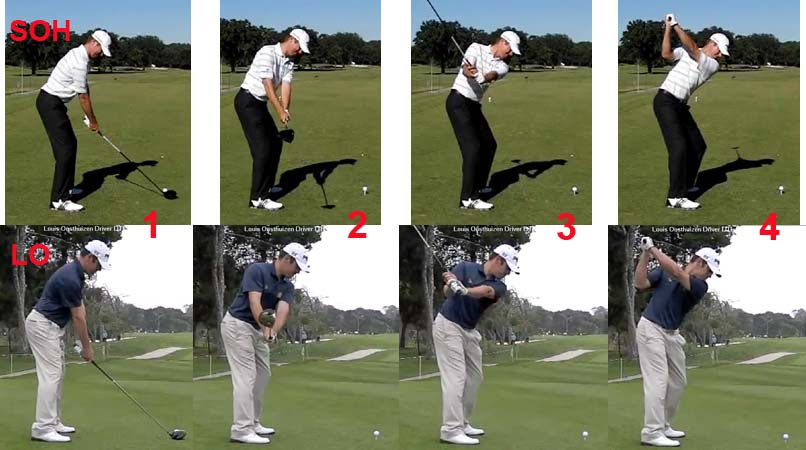
Sean O'Hair's and Louis Oosthuizen's backswing action - capture images from their swing videos
Image 1 shows their address position, and they are very similar, except that Sean O'Hair has slightly more bend at the hips.Image 2 shows their end-takeaway position. They both use a takeaway swivel action that gets the toe of the club pointing upwards at the end-takeaway position, and they both have their hands along the toe-line.
Image 3 shows their hand position when the left arm is parallel to the ground - note that Sean O'Hair is not pulling his hands more inward ("deep") than Louis Oosthuizen.
Image 4 shows their end-backswing position. Note that both golfers have their right forearm near-vertical to the ground, and there is "air" between the right upper arm and the armpit area of the right upper torso. In other words, a towel placed in the right armpit would fall-out during their backswing action, because they are not keeeping their right upper arm closely connected to the right armpit area of the right upper chest wall.

Sean O'Hair's and Louis Oosthuizen's downswing/followthrough action - capture images from their swing videos
Image 1 shows their end-backswing position; image 2 shows their position at the end of the early downswing; image 3 shows their delivery position; image 4 shows their impact position and image 5 shows their end-followthrough position.Note that both Sean O'Hair and Louis Oosthuizen have a near-identical arm motion in their downswing/followthrough action. They both use a CF-release action where they release their arms down-the-line away from their body and they both use a horizontal hinging action. They both allow their right wrist to straighten during the followthrough phase of the swing and they both use a finish swivel action where the right hand pronates over a supinating left hand during the finish phase of the swing (the finish swivel action phase of their swing is not shown in this sequence of capture images).
This type of arm action is very frequently seen in professional golfers and it is very different to the arm action seen in Dan Carraher's swing. Dan Carraher never lets his hands move so far away from his body in his followthrough - even when using a CF-release action. Dan Carraher always looks like he is "swinging left" after impact because his arms are more closely connected/coupled to his rotating torso, which rotates very actively inside-left after impact.
Example number 2:
Here is an example of a golfer who is using a followthrough action where the arms are closely coupled to the rotating torso during the followthrough.

Charley Hoffmann's followthrough action - capture images from a swing video
These capture images of Charley Hoffmann are derived from an U-tube swing video, which is no longer publically available. In this particular shot he hit a superb push draw shot on a par three golf hole and the ball landed a few feet away from the hole.Charley Hoffmann has a traditional rightwards-centralised backswing action swing style, but in this particular swing he rotates very actively through impact and he keeps his arms/clubshaft in front of his actively rotating torso throughout the followthrough. Note that he keeps his upper arms closely connected to his upper torso throughout the followthrough, and that gives one the impression that he is "swinging left" after impact. Note that he maintains a bent right right wrist throughout his followthrough action and he also uses angled hinging, which allows him to keep his clubface square to the clubhead arc during the entire followthrough phase of his swing. There is no roll-over of the clubface as occurs in a horizontal hinging action. This is an excellent way to perform a followthrough action, but it requires an inordinate amount of flexibility and athleticism - note how actively his right shoulder moves downplane under his chin and how actively he straightens his right arm (in a hitting type of action).
It is important to realise that a traditional golfer (who uses a rightwards-centralised backswing action swing style) can selectively use this type of followthrough action - and it is not only limited to golfers who follow the teaching of Sean Foley or a S&T golf instructor.
Conclusion:
The two main features of Sean Foley's golf instructional teaching are the utilisation of a centralised pivot action (vertical-centralised pivot action) combined with an active pivot action where the arms are closely coupled to the rotating torso throughout the backswing, downswing and followthrough. I personally think that there is nothing revolutionary in Sean Foley's teaching philosophy and these two main features are also seen in a S&T golfer's swing. I personally prefer Sean Foley's pivot action (compared to Bennett/Plummer's S&T pivot action), because he doesn't use an assertive "butt-tuck-under-the-spine" pelvic thrust action and a reverse C-finish action - which I regard as being "back-unfriendly" biomechanical actions. In that sense, I regard the Sean Foley swing style as being a S&T-lite swing style. I would recommend that golfers, who want to experiment with a vertical-centralised pivot action swing style, seriously consider using Sean Foley's S&T-lite swing style, rather than the standard S&T swing style, because I perceive it to be more "back-friendly". Golfers, who choose to use a vertical-centralised pivot action swing style, can also independently decide whether they want to couple their upper arms closely to their rotating torso, and whether they want to use a "swinging-left" type of followthrough action where the torso and arms appear to move inside-left as a single unit after impact.I think that Sean Foley's swing style is an excellent method of executing a full golf swing and it is a perfectly suitable alternative to the traditional rightwards-centralised swing style (as exemplified by Annika Sorenstam's swing), which is the style of golf swing that I have described in great detail in the main section of my website.
Jeff Mann.
February 2011.
References:
1. The Next Generation with Sean Foley DVD.

2. Review of Sean Foley's Next Generation DVD. Erik Barzeski.
http://thesandtrap.com/b/training/next_generation_with_sean_foley_dvd_review
3. The Stack and Tilt Swing. Michael Bennett and Andy Plummer.
4. The Golfing Machine. Homer Kelley.
5. Golf Annika's Way. Annika Sorenstam.
6. Alignment Golf. Lynn Blake and VJ Trolio.
